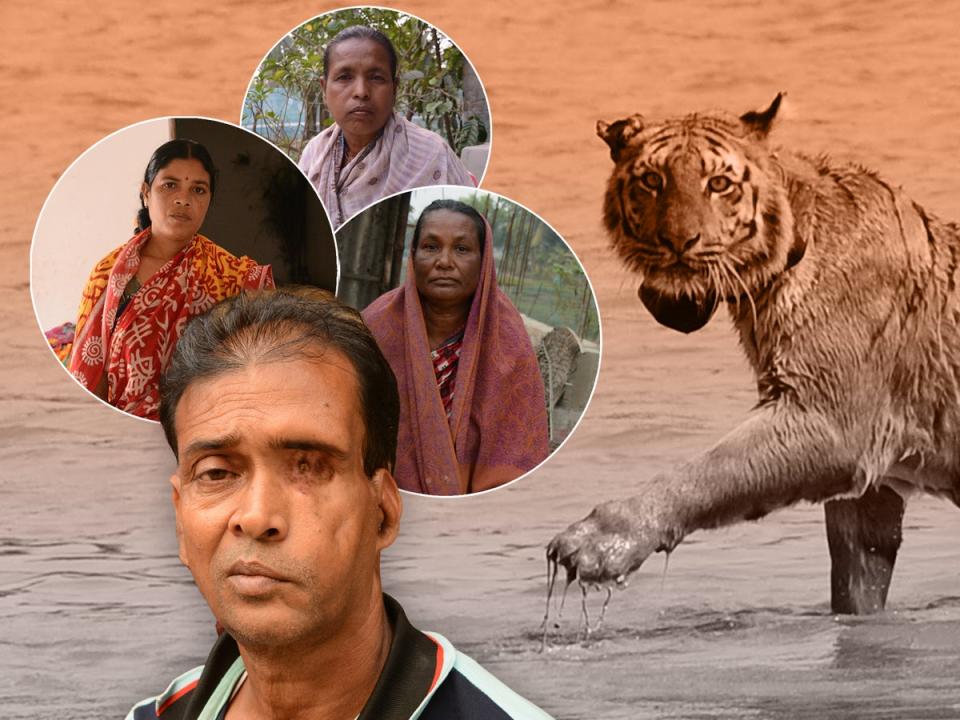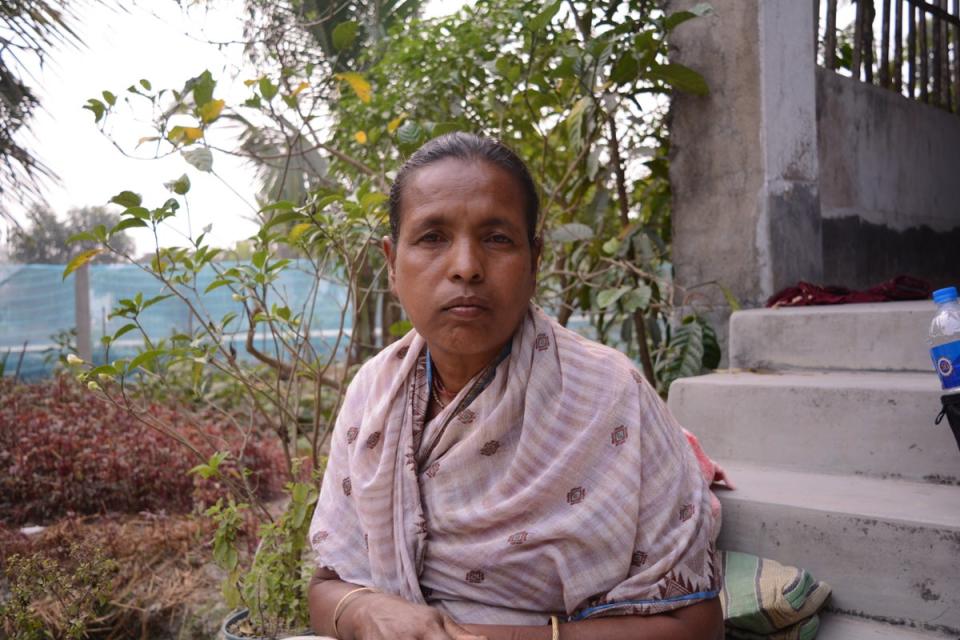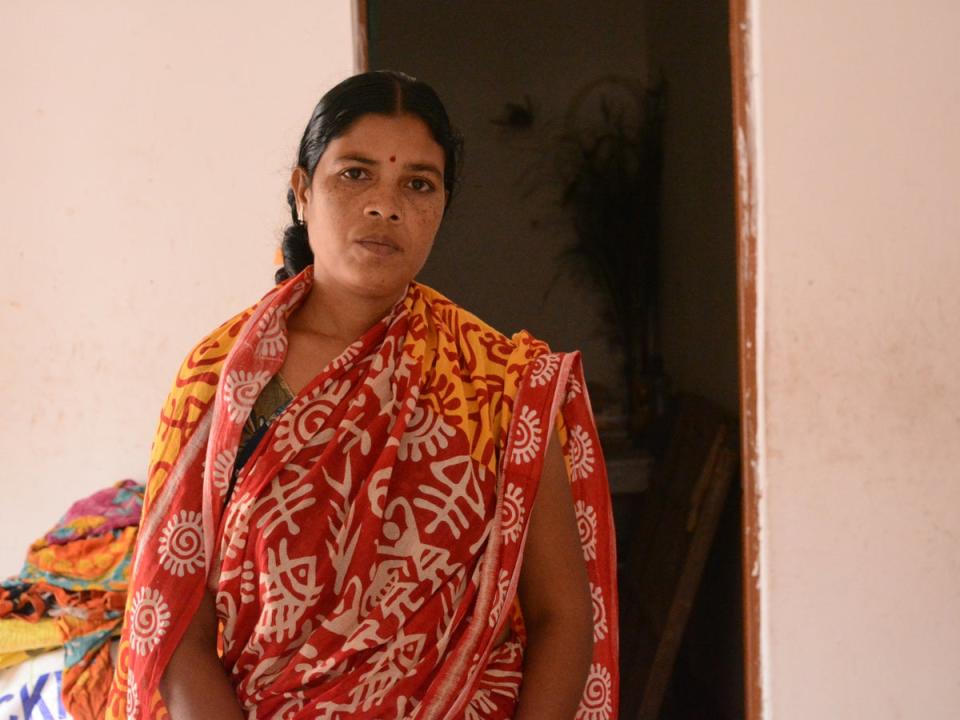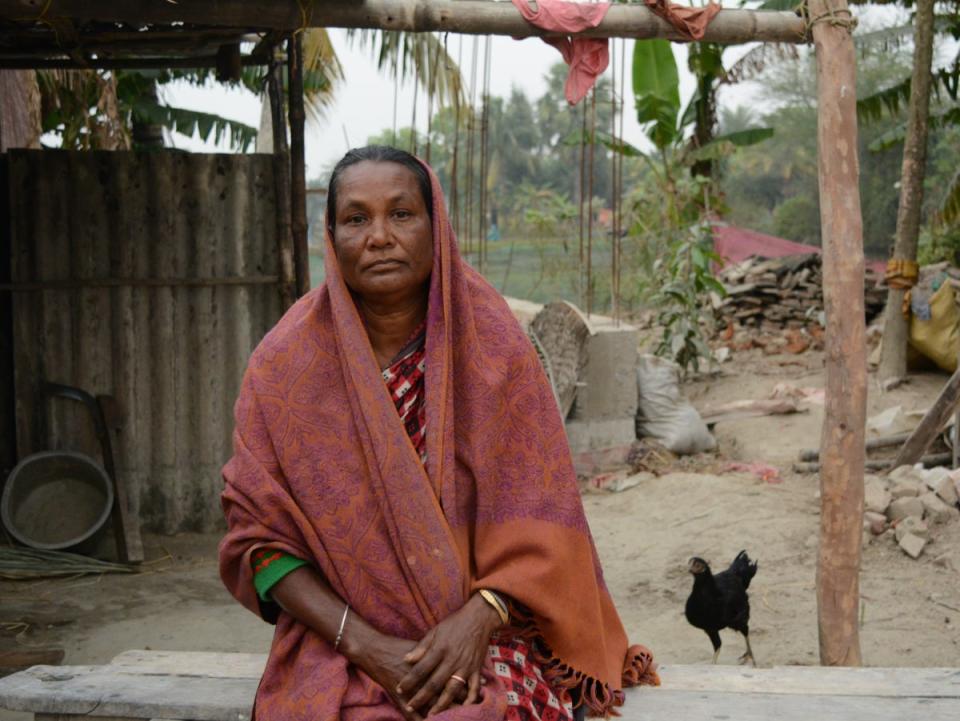Surviving a tiger attack: How hunters became the hunted

Despite living all his life in a remote backwater of India’s Sundarbans, 52-year-old Mihir Sardar’s only experience of tiger attacks was through stories circulated among his fellow villagers. After decades of fishing in the world’s largest mangrove forest without a single close encounter, he thought little of the dangers involved until a chilly December morning in 2021.
That day Sardar went fishing with his friend Babloo, taking his boat out at dawn and laying nets across a quiet stretch of brackish water. With the bulk of the work done by 8am, the pair planned to stay through the day and overnight before returning home with a full net around the same time the next morning.
“It was late evening. I was tired, I slept in the boat,” he recalls in an interview with The Independent at his home, no more than 25 miles from where they anchored their boat that night. “There were two doors on that boat. In front and at the back. So, while I had locked the front door, I forgot to lock the back door.”
It was an oversight that almost cost him his life, he explains. “That’s where the tiger came from and attacked me.”

Straddling the border between India and Bangladesh, the Sundarbans are home to the largest population of Bengal tigers anywhere in the world. There are around 100 on the Indian side of the national park, about 1,330 square kilometres of dense forest where the River Ganges meets the Bay of Bengal.
Tiger attacks are rare across the whole of India but particularly so in the villages bordering the Sundarbans. The big cats generally prefer to stay inside their semi-aquatic territories rather than venturing into populated areas, says Dr Yadvendradev Jhala, a wildlife conservationist and dean of the Dehradun-based Wildlife Institute of India.
Once humans enter their protected habitat, however, it’s a different matter.
“Tigers hunt by hearing here [in the Sundarbans] and anything that moves or makes a sound is on the menu,” Jhala says. “Sundarban tigers do not have the inherent fear of humans [that others do] as they may never have experienced humans as hunters in this habitat.”
Sardar admits to entering the protected area of the forest for what turned out to be his last fishing expedition, a mistake which turned into a 20-minute nightmare and left scars he will carry for the rest of his life.
“The tiger caught me by my left leg and dragged me into the jungle,” he recalls. “It was my friend Babloo who fought the tiger to save my life. While I held the tiger with his two front claws as it attacked me, Babloo managed to sit on the tiger’s back and tried to hold him by his head, trying to prevent it from eating me. Then he fell to the ground.”

Sardar explains that tigers typically only target one person that they have identified as prey during an attack, ignoring others in the process. “So, as Babloo tackled the tiger, I tried to slowly crawl back in the boat. Babloo threw mud in the tiger’s eyes.”
The tiger finally fled, and Sardar escaped by a whisker what would have been a deadly bite to the head from the cat’s jaws. But his injuries were still so severe that his life hung by a thread: the attack cost him a leg, an ear, an eye and part of the left side of his skull.
His friend Babloo saved his life a second time over, Sardar explains, by using mud to cover his wounds “in a bid to stop the bleeding”. “If I had lost more blood, I could have died there,” he says.
Because the attack occurred at night, the two had to wait on the boat until first light to make their way out of the forest and to the hospital. For the next two months, doctors there were unable to say with confidence whether Sardar would survive.
“Though I am back home now, there is a lot of pain,” Sardar says, nearly a year and a half after the attack. “A side of my skull looks flattened. But if you look at the CT scan, you will understand the scale of skull damage I have survived.”
Since the attack none of his family members have stepped foot in the forest. “My son has taken a loan to buy an auto (rickshaw), so we are no longer dependent on the forest as our source of income,” he says. “Now that I have survived the tiger attack, I cannot let another member of my family go through the same.”

There are more than 4.5 million people like Sardar living in traditional communities on India’s side of the Sundarbans, spread across its 54 inhabited islands.
These people are reliant on the forest’s resources for their daily needs and livelihoods, explains Dr Medha Nayak, a researcher at the Wildlife Trust of India, a conservation charity. Here, they hunt for crabs, prawns and other crustaceans, catch fish and collect honey and firewood.
Some resources are collected sustainably, but pressures on others have increased far beyond the supply available in the villages and border areas around the tiger reserve. “Over time the market demand for some specific items like prawns and honey has grown manifold,” says Dr Nayak. “The market is not limited [to India] but extends beyond, to the international market.”
The protected reserve doesn’t just provide a home to tigers – it is hugely biodiverse, supporting about 110 species of mollusc, 64 different kinds of crab and 165 species of fish, says Dr SP Yadav, a senior official at the federal National Tiger Conservation Authority. “Other than tigers, fishing cat and leopard cat are also found here. Spotted deer, wild pig, and Rhesus macaque form the major prey species of the tiger.”
So “conflict with wildlife in the human-dominated landscape cannot be ruled out,” he says. “The good part of the Sundarbans Tiger Reserve (STR) is that its core area is completely ‘inviolate’, meaning the core area is completely free from human habitations, as envisaged in the Wildlife (Protection) Act.

“The problem in STR is the illegal entry and illegal fishing by the locals, despite knowing the imminent danger of conflicts,” he says.
While Sardar survived his run-in with a tiger, there are others in his district of South 24 Parganas who were not so lucky. Among them is Binoy Sarkar, who was attacked in 2018 and whose remains were never found.
“He was cooking on the boat,” recalls his widow Geeta Sarkar. “Two more people had gone along with him. They were fishing. The tiger attacked [Binoy] near the neck and took him away.”
Sarkar says she and her husband were always dependent on the forest for food and whatever money could be made by selling Binoy’s catch. “I have six children. If he does not go to the jungle for fishing, how will we eat?” she asks. “There is no [other] means of livelihood.”
She says her husband and the others on his boat had paid for a pass to legally hunt and fish on the periphery of the tiger reserve, and that the family should therefore be owed government compensation for his death by tiger attack – Rs 300,000 (about £3,000), considerably more than the average yearly salary in India, and a potentially life-changing sum for Sarkar and her family.
But five years on from her husband’s death, Sarkar has received nothing. She says she saved up to travel to the government offices in Alipore, south of the state capital Kolkata, to first make a claim. “But there they told me to get his post-mortem report. I did not know at the time. So, I went back to the village.
“I returned to [Alipore] after I had enough savings to travel again. When I visited the office with the report, they told me that his case had slipped to the bottom of files. ‘We will let you know if we reopen it again,’ they said.”

Unlike Sarkar, Aparna Siyali had no awareness of her potential entitlements when her husband was killed in a tiger attack in 2016. “I did not apply for compensation because I did not know at the time [that it existed],” she says.
About nine months ago, she finally started receiving a basic state widow’s pension, but for many years after her husband’s death she struggled as the only breadwinner in the family, earning a fraction of what he had.
“When he was alive, we could earn up to Rs 8,000-10,000 (about £80-100)” a month, she says. “But after he passed away the [family] income went down significantly.” This was exacerbated by a severe gender pay discrepancy – ”for the same work, while a man receives Rs 300, I receive only Rs 150”, she says.
Dr Yadav says guidelines across India state that following any death by tiger attack that is proven in postmortem reports, the victim’s next of kin are entitled to around Rs 500,000 in compensation, adding that the “rates differ from state to state”.
But cases become more complicated when it is suspected that the victim had entered a protected area without permission. “Most of the human-tiger conflicts in tiger reserves take place because of chance encounters when people illegally enter into the reserve,” he says.
“In particular the encumbered tigresses (those who are pregnant or with young cubs) are extremely protective and when they see an intrusion… they attack human beings.”

“It is difficult for those venturing into the forest without permission to receive compensation,” admits a senior Sundarbans forest official, speaking on condition of anonymity.
But he defended the compensation system and said it was a smooth process in the case of victims who entered the forest with appropriate boat licences. “When we get the report of an accident, we conduct a spot inquiry, then we make a report and send it to higher-ups,” he says. “The kin always receives compensation on time. The entire process takes 20 days to a month at maximum.”
He says that the biggest challenge is spreading awareness among villagers of the rules, as well as precautions to take. “Attacks don’t take place when they fish in their boats, the problem arises only when they step out,” he claims, despite the contradictory experiences relayed to The Independent by survivors and relatives of those killed.
Locals say the official boat licences are prohibitively expensive, and that sometimes they have no choice but to hunt and forage in the forest to survive. This becomes the case for many more people in the aftermath of a cyclone – and studies have shown that the region is likely to be exposed to more powerful extreme weather events more often as the climate warms.
“After the cyclone hits, most of our crop produce gets wasted, the land remains saline for months if not years, and the fisheries and poultry farms get damaged,” says Aarti Mondol, a 60-year-old woman who lost her husband to a tiger attack about a decade back after Cyclone Aila struck the region.
“My husband had just entered the forest for fishing,” she says. “The tiger swam through the river and attacked him.”

She stopped allowing her son to venture anywhere near the forest after her husband’s death, but finding a safer alternative for him to make a living wasn’t easy. “My son drives this car that we bought on loan, and takes it to other states [as a taxi driver],” she explains. He earns only Rs 4,000-5,000 (£40-50) a month – not enough for the family to be comfortable, she says, but better than losing another family member to a tiger.
A local NGO named Goranbose Gram Bikash Kendra (GGBK) claims that alongside cyclones, other external factors can lead to sudden changes in the dynamic between humans and tigers in the Sundarbans.
One that they cite is the Covid-19 pandemic. The first Covid wave in India was characterised by a dramatic migration of workers out of locked-down cities back to their home villages, using whatever means of transport they could find.
Nihar Ranjan Raptan, the founder-secretary of GGBK, says this influx of people to the rural Sundarbans increased the pressures on forest resources and, in the process, the risk of tiger attacks. “Due to the pandemic, they lost their jobs and there was reverse migration and they were not able to go outside the state. So they had no work in the local area,” he says.
Figures compiled by GGBK and first reported by The Hindu last October show that while 30 tiger attacks took place in 2019, this went up sharply to 78 in 2020, the first year of the pandemic, and stood at 60 in 2021.”

Human-tiger conflict incidents do shoot up at times, says Dr Anamitra Anurag Danda, a senior visiting fellow with Observer Research Foundation. “This may be attributed to higher dependence of the local population on forest resources in times of crises such as Cyclone Amphan coinciding with Covid-19 lockdown.”
Cyclones can also cause damage to the nylon net fences which have otherwise proven effective at discouraging tigers from entering areas of human habitation, he says. “This could also be a reason for spurts in human-wildlife conflict following high-intensity weather events.”
But he adds that such spikes do not necessarily mean tiger attacks are on the rise, saying that “in general, there is no growth in human-wildlife conflict”.
And Dr Yadav says claims of a link between India’s mass Covid migration and increased conflict with tigers is not supported by the government’s own statistics. The data from the last four years show “no specific trend in human-tiger conflict in and around STR”, he says.

There is consensus, however, over the efforts needed to reduce the dependence of the locals on the forest in a bid to reduce human-animal encounters.
“Schemes [like] ‘Ujjawala’ providing cooking gas to the poor people is helping a lot to reduce their dependency on wood from forest areas for fuel,” says Dr Yadav, while conservationist Dr Jhala says that the Tiger Task Force has recommended sharing “30 per cent of revenues generated from gate receipts and from ecotourism activities” with the buffer zone communities.
“The government (park management) needs to provide economic benefits by sharing profits obtained by the Tiger Reserve with the buffer zone communities,” says Dr Jhala.
“If these are not sufficient the Central and State governments need to provide funds to subsidise the livelihood opportunities lost due to creation of the core area of the Tiger Reserve,” he says adding “the citizens of India and the world need to bear this cost of conservation, not the poor local communities.”
Additional reporting by Alisha Rahaman Sarkar
For the first part in our series on 50 Years of Project Tiger, read here about how a decorative shrub introduced by the British to India is now threatening tiger habitats.

 Yahoo Sport
Yahoo Sport 





































